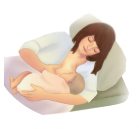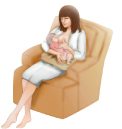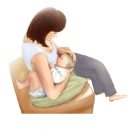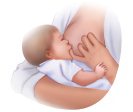Q: What can I do to produce enough breast milk?
A: 1. Eat five food groups and the amount should not be less than what you take during pregnancy. Also, drink sufficient clean water.
- Breastfeed the baby frequently, or every 2-3 hours during the early stages. Have the baby empty the breast of its milk. The more frequently the baby is breastfed, the more breast milk is produced.
- Do not give formula, water, or food. It will make the baby full and suck less frequently at the breast which will lead to less milk being produced.
Q: I have small breasts. Will I be able to produce enough breast milk to breastfeed my baby?
A: The size of the breast does not reflect the amount of breast milk that a mother can produce. In fact, it is all about stimulation. It is recommended that the mother breastfeed the baby every 2–3 hours or at least eight times a day. This will help stimulate the production of breast milk enough to meet the baby’s needs. The holding position also matters. A correct posture will not only help the baby suckle comfortably but also prevents the mother feeling any pain in the nipple and the occurrence of cracked nipples.
Q: Can I breastfeed if I have flat or inverted nipples?
A: Inverted nipples include ones that are not only flat but also inverted. They are quite rare. However, if you have this type of nipple, you still can breastfeed your baby with the help of your lactation consultant.
For those who have inverted nipple, massaging and pulling your nipples gently usually produce a positive result. You can do this twice a day while taking a shower. You can also try to use a breast shell to help keep the nipple to stick out.
For those who experience a hard areola, try massaging to soften the area and slide as much areola area as possible into the baby’s mouth while you latch. You may need to consult with a breastfeeding specialist.
Q: What kinds of food and drinks should I avoid?
A: Avoid caffeinated drinks, such as coffee and tea, and also alcohol. Breastfeeding mothers should have all five groups of food. In addition, they need an extra 500 kcal just as when they are pregnant. Always observe any reactions that the baby produces to breast milk after you have eaten something. If there are any reactions, you should avoid eating that food again.
Q: What to do when I have cracked nipples?
A: Correct position and latch are the keys to prevent cracked nipples.
- Hold the baby in the right posture and the baby’s mouth needs to be able to cover as much area of the areola (gums pressing against the areola).
- Start from the breast that is in less painful. If the baby starts to suck hard, change to the other breast. Try to breastfeed the baby with both breasts each time.
- Do not apply soap or lotion on the nipples as this will cause the nipples to dry and cause cracking. Always squeeze out breast milk and apply it on the nipples after breastfeeding. Then wait until the nipples are dry before putting on a brassiere. You can also apply 100% Lanolin to your nipples after feeding.
Q: My nipples hurt and I have cracked nipples. Should I breastfeed the baby?
A: Do not stop breastfeeding if the condition is not really bad. Here are some tips for breastfeeding if you are experiencing the above mentioned problems:
- Start from the breast that is less painful
- Wait until the baby’s mouth is wide open. Then hold the baby close to the breast. Have the baby suck deep enough that you do not feel any pain
- Hold the baby tighter against the breast. This helps the baby to be able to cover a wider area of the nipple and areola which lessen the pain when the baby sucks.
- If you develop severe cracked nipple, avoid using that breast for 3-4 feedings or until you feel better before breastfeeding from both breasts again. In the meantime, the breast in pain still needs to be emptied by pumping regularly.
Q: The baby excretes every one to two days. Is this normal?
A: After the first month, this is normal. It is even possible that babies who are only breastfed excrete just once in five to seven days. This is because breast milk is very easy to digest and produces very low amounts of feces. It is also normal if the baby produces watery and yellow stool several times a day.
Q: Should I wake the baby up for breastfeeding?
A: In the early stages, the baby needs to be breastfed very frequently. If the baby falls asleep while breastfeeding, try waking the baby up by changing the nappy or swapping the baby to the other breast. Do not cover up the baby because warmth makes the baby sleepy and refuse to suck. Once your milk is in and the baby is gaining weight well, you can do demand feeding.
Q: Can I still breastfeed my baby if I have to take medicine?
A: If you are sick, inform the doctor that you are breastfeeding a baby so that the doctor can prescribe medicine that is safe. Mostly, it is not recommended that you stop breastfeeding when you are sick. Breast milk contains white blood cells and antibody that can strengthen the baby. However, it is advisable that the mother consult the doctor before taking any medication because some medicines are passed through the breast milk and can be dangerous to the baby.
Q: How can I breastfeed if I have to go to work?
A: For working moms who have to leave the house to work, it is still possible that they can breastfeed their babies. During maternity leave in the first 4 to 6 weeks, breastfeeding should be the only option. One month before going back to work, start stocking breast milk by storing expressed breast milk in the refrigerator or freezer for the baby when you have to go back to work. You may want to try giving expressed breast milk once a day after the baby is one month old so he or she will get use to the bottle.
Q: Should I have the baby suck breast milk from a baby bottle when I leave home?
A: During the first month, it is advisable to feed the baby by spoon or baby cup feeder to prevent nipple confusion. After one month usually breastfeeding is already established.
Q: When should I feed my baby with food that is suitable for his/her age?
A: The World Health Organization (WHO) advises that breast milk should be the only food for a baby during the first six months. Then mothers can feed their babies with food that is appropriate for the age, along with breast milk, until the baby is two years old or older.
Q: What is difference between fore milk and hind milk?
A: Fore milk is the first half of your breast milk which is high in lactose. Hind milk is the second half of your breast milk which is high in fat.
It is important that your baby empty one breast at a time before changing to the other side. By emptying the breast, your baby will get both the fore milk and hind milk. The fat content in the hind milk will help your baby stay full longer and will need less frequent feeding.
By switching side too soon, your baby will end getting only milk that is high in lactose, which makes your baby hungry more often and sometime is the cause of gas, bloating, stomach aches and frequent stools. Fat content in your hind milk will also help your baby gain weight faster.
Q: How do I empty one breast?
A: By feeding your baby on one breast as long as he or she wants. In other word don’t time the feeding. Some baby takes longer, some baby is able to empty your breast in a very short time. Some baby get full from one breast while some baby will feed from both breasts.
Q: What is the benefit of expressing (either hand or machine)
A: – By feeding regularly and expressing (if baby only gets full after one breast or starts to sleep longer), you will be able to maintain and sustain your milk production and build up your storage
– It will help you ready to continue to produce milk as long as you desire even up to one year or longer
– Once your baby is older than one month you can give milk from the bottle occasionally without interfering with your nursing. This way, you can get some more rest, or can go out. Your husband or other family member will get a chance to feed your baby. Your baby will learn to drink from bottle, so in a way preparing he or she when you need to go back to work.
– By keep expressing you will have enough storage and do not need to use formula which is save your money.
– Milk storage will enable your baby to continue receiving all the benefits of breast milk without interruption even if you feel sick or need some treatment that might be contraindication to breastfeeding.
Q: What are the signs and symptoms of mastitis?
A: Mastitis is an infection that develops within your breast. The cause can be bacteria or yeast. You will be more prone to develop mastitis. If you have a cracked nipple or blocked duct which is left unconverted.
Breast pain is the most common symptom. Reduce of the skin overlying your beast is a sign. Fever and chill also are common symptoms. If you experience these symptoms, you should seek medical attention and require treatment immediately. Complication of mastitis is breast abscess.
Q: What a blocked duct?
A: When one area of your breast does not get empty, milk just stays there and the duct which normally opens at the nipple will be blocked. You may experience a lump in that area or painful when baby is nursing. Sometimes you may see a white dot at your nipples. If this happen, try massaging your breast, change feeding position, pumping or nurse more often. After following these tips and you still experience these symptoms. We would recommend you to consult with lactation consultant.
Q: When can I get help with breast feeding problems?
A: At Samitivej, our staffs in the Women Health Center, delivery room, post-partum and nursery receive regular training about how to help mom with breast feeding. Our hospital received accredited Baby Friendly Hospital (BFHI) and Sai Yai Rak Award. We also have lactation clinic with lactation consultant specialist who are certified International Board Certified Lactation Consultant (IBLC) to help you during your post –partum.
For further information, please contact:
Sukhumvit Campus, 2nd Floor, Building 1
Tel: 66 (0) 2022-2236-7
Call Center: +662-0-222-222
E-mail: info@samitivej.co.th
Facebook:https://www.facebook.com/SamitivejInternationalChildrensHospital
The Lactation Clinic
Building 2, 2nd Floor
Tue, Wed 9 AM. – 12 PM., Thu 10 AM. – 12 PM.
Tel. +662-022-2238
Nursery: NICU (24 hours)
Building 1, 4th Floor
Tel.+662-022-2345
——————————-
Srinakarin Campus, 4th floor
Tel: 66 (0) 2378-9082-83
Call Center: +662-0-222-222
E-mail: info@samitivej.co.th
Facebook: https://www.facebook.com/SamitivejInternationalChildrensHospital







